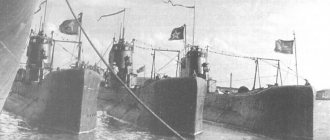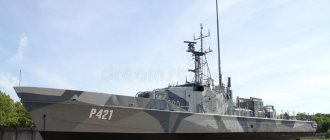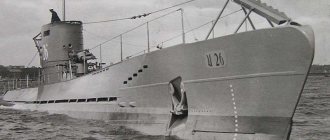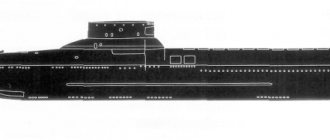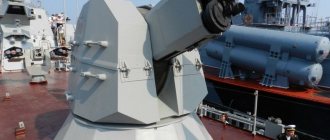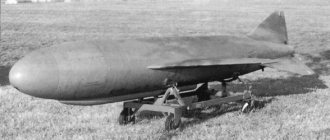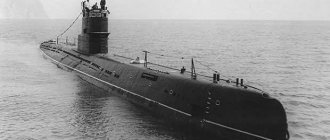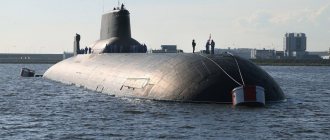Non-nuclear submarines of the Type 212A and Type 214 projects
In the early nineties, the German military came to the conclusion that the Klass 206 diesel-electric submarines in the navy were becoming obsolete and required replacement. There were certain plans to modernize this equipment, but it was necessary to develop new submarines of a similar class, which in the foreseeable future would strengthen the Navy and replace decommissioned equipment. It was proposed to develop the new project taking into account the operation of submarines over the next few decades. For this reason, it was decided to use the latest technologies that could extend the possible service life as much as possible and provide the highest possible performance. At the same time, Italy also showed its interest in promising submarines. In the last decades of the last century, the countries of Western Europe jointly created a large number of types of various military equipment, so they decided to also make a new submarine together. An agreement to implement a joint project was reached in 1994. By this time, the German military assigned the name “Type 212” to the promising project. Soon an Italian name appeared: Todaro, after the supposed name of the lead submarine for the Italian Navy.
It should be noted that the navies of the two states had different requirements for new submarines. For example, Germany needed submarines capable of operating primarily in the shallow depths of the Baltic Sea, and Italy wanted to receive similar ships adapted to the conditions of the Mediterranean Sea. Based on the results of discussions and consultations, the parties came to a compromise solution. The requirements for the new project were formed taking into account the wishes of both countries. Following the emergence of new requirements, Germany changed its project designation to "212A".
In 1996, the parties signed a memorandum, according to which the development of a new project began. By this time, the basic requirements for promising submarines had been determined. Their design and on-board equipment required the use of the latest technologies, which were supposed to provide the highest possible performance. Thus, it was necessary to equip the new Type 212A submarines with an air-independent power plant, ensuring the possibility of a long stay at depth. The use of such systems allows the boat to be classified as non-nuclear submarine (NSPL). In addition, it was necessary to reduce noise and use other techniques to reduce visibility.
The German companies Howaldtswerke-Deutsche Werft GmbH (HDW) and Thyssen Nordseewerke GmbH (TNSW) were involved in the development of the new project. The memorandum stipulated the construction of six Type 212A submarines. Four units were planned to be built at German enterprises and transferred to the German Navy, two more were to be built in Italy for its needs. In addition, the Italian Navy was left with the option of ordering two additional submarines. The Fincantieri and Muggiano shipyards were to build submarines for the Italian Navy.
Construction of the 212A submarines started in 1998. German shipbuilders, as previously planned, received an order for four ships, Italian - for two. Subsequently, both sides exercised their right to increase the series by ordering two additional boats. Soon after the start of construction, new submarines in a modified form were offered to potential buyers in the form of foreign navies. It was assumed that new technologies and high performance would be of interest to new customers.
The authors of the Type 212A project had to fit all the necessary components into the hull, taking into account the operation of submarines in the Baltic Sea. Thanks to a number of technical solutions, primarily related to the layout of external units, the new NSSNs are capable of diving in water areas with a depth of at least 17 m. The total length of the “212A” submarines in the basic version of the project is 56.08 m, width – 7 m, normal draft – 6 m. When surfaced, the displacement is 1580 tons, when submerged - 1990 tons.
Type 212A submarines have a double-hull design. The durable body is made of low-magnetic steel alloys, and the lightweight body is made with extensive use of reinforced fiberglass. The design of the robust housing is of great interest. It consists of two cylindrical units connected by a compartment in the shape of a truncated pyramid. Inside the larger diameter bow cylinder is the bow compartment with torpedo tubes and all the habitable spaces. The aft part of the hull and the “adapter” are given over to the placement of various units of the power plant. In addition, gas cylinders for storing oxygen and hydrogen are located outside the aft part of the pressure hull.
In order to increase the time during which the submarine can remain under water, the Type 212A project used a rather complex, but very interesting combined non-nuclear power plant. When moving on the surface or at shallow depths, the power source must be the MTU 16V-396 diesel engine. It is connected to a generator that supplies electricity to lead-acid batteries and a 1,700 hp Siemens Permasyn electric motor. The latter drives a propeller with seven saber-shaped blades.
For covert movement at depth, Type 212A submarines can use their power plants in an air-independent mode. In this case, oxygen-hydrogen fuel cells based on a polymer electrolyte are used as an energy source. The lead submarine for Germany (U31) had a battery of 9 such units with a power of up to 40 kW each, developed by HDW and Siemens. The following submarines use two 120-kilowatt elements from the same companies. Fuel cells require a supply of hydrogen and oxygen to operate. Volumetric cylinders for storing this “fuel” are placed inside a lightweight body. Oxygen cylinders are located on the upper surface of the durable body, hydrogen cylinders are on the lower surface.
According to available data, the air-independent power plant used is highly efficient, including in comparison with the diesel generator used. The efficiency of diesel generators usually does not exceed 30-35%. Fuel cells installed on Klass 212A submarines are capable of delivering up to 60-65% of hydrogen energy. However, fuel cells have certain limitations on maximum power, which is why all versions of the project use batteries from such units.
It is claimed that the high efficiency of fuel cells, combined with the large volume of gases stored on board, allows Type 212A submarines to remain at sea for three months. Continuous stay under water is allowed for 21 days. At this time, the non-submarine submarine does not need regular ascents to turn on the diesel engine and recharge the batteries. Depending on the need, the crew can combine the operation of power plant units. Thus, to accelerate to maximum speed, it is possible to use batteries and fuel cells together.
When on the surface, Type 212A submarines can reach speeds of up to 12 knots. Maximum underwater speed is 20 knots. The maximum cruising range of 8 thousand nautical miles is achieved on the surface at an economic speed of 8 knots. When moving at depth, the duration and range of voyage are significantly reduced. However, even in this case, the new submarines retain fairly high characteristics. For example, in April 2006, the German submarine U32 set off from its base on the Baltic Sea and reached Spain in a few days, covering 1,500 nautical miles. The durable hull allows the 212A submarines to dive to depths of up to 700 m.
The armament of the Type 212A submarines consists of six 533 mm torpedo tubes located in the bow of the hull. The devices are located in three tiers, two in each. The bow compartment of the submarine has space to carry 13 torpedoes. It is allowed to use weapons of different types with different characteristics. A promising IDAS missile is being developed specifically for the Type 212A NS submarine, which is supposed to be launched through a torpedo tube. If necessary, dumpers for 24 sea mines can be installed on the outer surface of the light hull of submarines.
The crew of the new German-Italian submarines consists of 27 people, including 5 officers.
To monitor the situation and search for targets, the crew must use an integral complex of various means. There is a set of sonar systems, including a towed station and a sonar for searching for mines. The submarine is also equipped with two Zeiss Optronik periscopes. To search for targets, it is proposed to use a SERO 14 periscope with an optical rangefinder, a thermal imager and the ability to determine target coordinates. The Zeiss SERO 5 periscope is equipped with a laser rangefinder and is designed to carry out an attack.
On July 1, 1998, the laying ceremony of the lead non-nuclear submarine Type 212A, designated U31, took place. This NSPL was built for the German navy. The boat was launched in March 2002, and in the fall of 2005 it was accepted into the fleet. In 2000 and 2001, three more submarines of the project with numbers from “32” to “34” were laid down. All of them were commissioned in 2005-2007. Soon after this, the construction of new submarines for the German Navy continued. The German military wanted to purchase two additional submarines.
According to available data, these two Type 212A submarines were built according to a slightly modified design that differed from the basic one. First of all, the complex of on-board equipment has undergone major changes. In addition, it was planned to ensure the possibility of effective combat work in tropical climates. The service of the two modernized submarines began in 2011 and 2013.
The first non-nuclear submarine Type 212A for the Italian Navy was named Salvatore Todaro and was laid down in July 1999. In May 2000, the keel of the Scirè submarine took place. These ships were launched in November 2003 and December 2004, respectively. Since March 2006 and February 2007, they have served in the Italian Navy. In August 2008, the Italian military, which by this time had already gained some experience in operating new submarines with an air-independent power plant, ordered the construction of two new NS 212A/Todaro. In accordance with the contract, two new boats must be built, tested and delivered to the customer in 2015 and 2016.
As already mentioned, soon after the start of construction of the Type 212A submarines for the navies of Germany and Italy, an export version of the project was created and offered to foreign customers. Since the 212A project managed to introduce a number of new technologies, such submarines should have been of interest to foreign militaries. However, it was planned to remove some features from the export version of the project in order to preserve the advantages of the submarines built for the German and Italian navies.
The export version of the non-nuclear submarine “212A” received the designation “Type 214”. The most significant changes introduced in this project affected the materials of the durable hull. Thus, boats of the basic Type 212A project have a low-magnetic hull, which reduces the likelihood of their detection using magnetometers. Export submarines should receive a “regular” pressure hull that does not have such special properties. In addition, certain adjustments were made to the composition of equipment and weapons.
A curious feature of the Klass 214 export project was a proposal concerning the order of construction of the ordered equipment. New submarines could be built both in Germany and at enterprises of the customer country. Most customers expressed a desire to master the independent production of new equipment: only 3 of the 23 Type 214 submarines ordered so far have left the HDW stocks. The rest were built, are being built or will be built by the customer.
Greece became the first customer for the new export submarines. At the request of the Greek military, German specialists modified the complex of on-board equipment, replacing some of its components. At the end of February 2001, the laying of the first submarine “214” for the Greek Navy took place. The Papanikolis submarine was built at a German shipyard and tested by HDW specialists. Subsequently, production was carried out by Greek industry. For certain reasons, the lead boat of the Greek order entered the fleet only in 2010. Since 2004, it has been undergoing testing, which was seriously delayed due to a number of technical problems. As a result, the construction of submarines for Greece continues far behind the original schedule. Thus, in 2015 it is planned to deliver the second submarine of the series, Pipinos, laid down back in 2003. In total, Greece wants to receive six German-designed submarines. Four were ordered in 2000, two more in 2010.
Also in 2000, a contract was signed with South Korea, which included the construction of three boats. The lead ship, Son Won-il, was laid down in 2002 and delivered at the very end of 2007. At the moment, the Republic of Korea Navy has four Type 214 nuclear submarines, the last of which is being built under the second contract from 2008. Then the South Korean military acquired the right to build six more new submarines. All five remaining submarines are at various stages of construction. It is noteworthy that the first three submarines for the South Korean fleet were built by Hyundai Heavy Industries, and two more shipyards had to be involved in fulfilling the new order.
In 2005, Portugal ordered two Klass 214 non-nuclear submarines. Due to the lack of necessary production capacity, official Lisbon ordered the construction of the HDW company. The ordered submarines entered service with the Portuguese Navy in 2010 and 2011.
In 2008, it became known that Pakistan was showing interest in Type 214 submarines. This country could buy at least three submarines, as Pakistani and German officials have repeatedly said. The first boat of the contract could be built and delivered to the customer within 64 months from the date of signing the agreement. The transfer of the second and third submarines could take about another year. There were high hopes for the contract with Pakistan, but the potential customer hesitated for several years. As a result, the Pakistani military became interested in Chinese developments and stopped negotiations with German shipbuilders.
Since the end of the last decade, negotiations have been ongoing with Turkey. This customer wanted to build six new submarines on his own. The negotiations were fraught with some problems. In particular, the Turkish military wanted to receive equipment with a modified set of equipment. In 2009, the first cooperation agreement was signed, and in July 2011, a firm contract worth 2 billion euros appeared. Construction of the 214 submarines will continue until the end of the decade.
In March 2011, Poland signed an agreement with France, according to which licensed construction of Scorpène-class non-nuclear submarines should begin at Polish shipyards. Previously, the Polish military showed interest in the German Type 214 project, but after analyzing foreign proposals, it was decided to settle on a French-designed submarine.
It should be noted that the export version of non-nuclear submarines of German-Italian design was not without noticeable shortcomings. As in the case of the Klass 212A project, German shipbuilders had to identify and correct shortcomings during testing, under the close supervision of the customer. For example, the first NSPL for Greece (Papanikolis) could be transferred at the end of 2006 or beginning of 2007. However, during the tests, overheating of the fuel elements, unacceptable cavitation on the propeller, too much rolling during waves, etc. were revealed. These problems almost turned into an international scandal. Greece refused to accept the submarine with problems, and soon a journalistic investigation appeared in the Greek media, exposing the quality of the ordered ship. Over the next few years, German shipbuilders were fine-tuning the export boat, which was again put out for testing in 2008. Due to all these events, the Papanikolis submarine became part of the Greek Navy only in the last months of 2010.
In 2008, reports appeared in the South Korean press about certain shortcomings of the ordered German submarine related to the operation of the power plant. However, this information has not received official confirmation. According to official sources, the South Korean Navy is completely satisfied with the new submarines. One of the results of this can be considered a new contract for the construction of six additional submarines.
To date, German and Italian enterprises have built a total of 12 Type 212A non-nuclear submarines with an air-independent power plant. In addition, 6 submarines of the Type 214 export project were built and delivered to the customer. New orders for the supply of NSBNs of the basic project have not yet appeared. In the foreseeable future, 17 export-project submarines will be built, tested and delivered to the customer. In addition, new orders may appear from countries that have not yet shown interest in the German-Italian project.
The Klass 212A non-nuclear submarine project was created with extensive use of the latest technologies, such as an air-independent power plant, low-magnetic steel pressure hull or the most modern sonar equipment. All these ideas and solutions allowed Germany and Italy to create modern submarines and, with their help, maintain the required combat capability of their naval forces. In addition, an export version of the project was created, which, despite the exclusion of some know-how, was able to interest foreign buyers.
Currently, Project 212A submarines are among the representatives of the not yet very numerous class of non-nuclear submarines with an air-independent power plant. In addition, the export version of “214” still has almost no competitors on the international arms and equipment market, which to a certain extent contributes to the emergence of new contracts. Thus, belonging to a small class of promising technology, as well as the presence of several export and licensing contracts, allows us to consider the “212A/214” project one of the most successful modern developments in the field of the submarine fleet.
Based on materials from the sites: https://globalsecurity.org/ https://militaryfactory.com/ https://naval-technology.com/ https://marine-portraits.de/ https://janes.com/
Links
Wikimedia Foundation. 2010.
See what “German Project 212 submarines” are in other dictionaries:
German Type VII Submarines - Type VII Submarine U Boot Class VII Main Characteristics Ship Type Medium Submarine Submarine Project Designation... Wikipedia
German submarines type VIIB - Type VII DPL U Boot Class VII Main characteristics Ship type Medium DPL Project designation ... Wikipedia
Submarines - Russian nuclear submarine of the "Akula" type ("Typhoon") Submarine (submarine, submarine, submarine) a ship capable of diving and operating underwater for a long time. The most important tactical property of a submarine is stealth... Wikipedia
Submarines of Project 212A - Submarines of type 212 (212A) Type U 212 ... Wikipedia
Submarines of Project 212 - Submarines of type 212 (212A) Type U 212 History of the ship Flag state ... Wikipedia
Submarines of Project 214 - Submarines of type 212 (212A) Type U 212 History of the ship Flag state ... Wikipedia
Submarines Type 212 - (212A) Type U 212 History of the ship Flag State ... Wikipedia
Submarines of Project 206 - Submarine of Project 206 Klasse 206 ... Wikipedia
Submarines of type 206 - DPL project 206 Klasse 206 History of the ship Flag state ... Wikipedia
Submarines of Project 201 - Submarines of Project 201 Klasse 201 History of the ship Flag State ... Wikipedia
General characteristics [edit]
Docked in HDW / Kiel
Todaro
at Fincantieri dock, Mugiano.
- Displacement: 1450 tons surface, 1830 tons underwater.
- Length: 56 m (183.7 ft), 57.2 m (187.66 ft) (2nd batch)
- Width: 7 m (22.96 ft)
- Draft: 6 m (19.68 ft)
- Propulsion: 1 diesel MTU 16V 396 [2]
- 9 HDW/Siemens PEM fuel cells, 30–40 kW each (U31)
- 2 HDW / Siemens PEM fuel cells 120 kW (U32, U33, U34)
- 1 Siemens Permasyn
Electric motor 1700 kW, driving one of the seven-bladed heel arch propeller
- 8,000 nautical miles (14,800 km or 9,196 mi) at 8 knots (15 km/h)
- 6 torpedo tubes with a diameter of 533 mm (in 2 forward-facing asymmetric groups: left 4 + right 2) with 13 [6] torpedoes or 24 pipe mines [23]
- Tau
Torpedo Defense System , 4 launchers, 40 jammers/decoys
- set
STN Atlas
DBQS40
: Passive low-frequency sonar with towed antenna array
TAS-3
(deploys from the sail)
- Carl Zeiss SERO 14
, with FLIR and optical rangefinder
, with laser rangefinder
I band navigation radar
ESM package
Power plant
The German boat is equipped with a combined air-independent power plant (DEU + ECG). The main feature of such an installation is the electrochemical generator (ECG) included in its composition, in the fuel cell modules of which electrical energy is released when hydrogen and oxygen are combined. In this case, energy generation occurs silently, and the by-product of the reaction is distilled water, which can easily be used on a submarine.
This installation significantly increases the range and cruising time of the boat at low noise speed (3-5 knots). On the other hand, storing liquid oxygen on board a boat increases the likelihood of an explosion. It should also be noted that, despite the obvious advantages of the electrochemical generator, it does not provide advantages when performing high-speed maneuvers when pursuing a target or evading an enemy attack - in terms of maximum underwater speed, the German and Russian boats are almost equal - 20 knots for U-212 and 21 Project 677 with electric motor power of 3875 hp. for U-212 and 4100 hp. project has 677.
In addition, according to reports from a number of sources, the German MTU-16V396 diesel engine installed on the first series of boats of type 212 raises complaints about its reliability, which is why it was necessary to rework the power plant on boats of the following series.
The Russian boat is equipped with a traditional diesel-electric plant (DEU) with full electric propulsion (diesel is used as an electric generator, which increases the efficiency of the boat and reduces its noise). In a submerged position, the boat can move both on an electric motor and under diesel engines, which in this case receive air through a snorkel. The power of diesel engines allows the boat's batteries to be charged in an accelerated mode, which significantly reduces the time the submarine remains in the periscope position, increasing its stealth.
Stealth
The level of stealth of modern boats is one of the most secret and most discussed aspects. Objective data in the form of “noise portraits” of both submarines, which would make it possible to compare their stealth, are not available, and advertising brochures are not very reliable. The only way to compare the noise level of both boats is to compare them using indirect parameters. Currently, the following known facts can be used for comparison.
In June 2003, the nuclear-powered missile cruiser Pyotr Velikiy took part in maneuvers during which it searched for and located the Project 877 Halibut submarine (a previous generation compared to the Project 677 and U-212 submarines). The Polynom sonar system installed on the Petra made it possible to detect the submarine only after the submarine “conditionally sank” the cruiser with four torpedoes.
At the beginning of June 2006, the Baltic Fleet patrol ship Neustrashimy participated in the international exercises Baltops-2006, during which it detected and for some time pursued an underwater target, later identified as a U-212 type boat. Considering that the hydroacoustic complex installed on the Neustrashimy is significantly inferior in its characteristics to the Polynomial of the nuclear-powered missile cruiser, we can conclude that the old Project 877 submarine is at least not inferior in stealth to boats of the U-212 type. At the same time, based on the test results of the lead boat of Project 677, it is known that submarines of this type are six to eight times superior to Project 877 in terms of stealth, which allows us to conclude that these boats are significantly superior to U-212.
Notes
- [www.industry.siemens.de/marine/en/solution/pma_detail.htm?id=795&family=SINAVY&PIdent=&SIdent= Siemens SINAVYCIS Permasin]
- [www.militaryparitet.com/teletype/data/ic_teletype/12712/ Submarine U-35 launched]. www.militaryparitet.com (November 17, 2011).
- [www.ndr.de/nachrichten/schleswig-holstein/Hochmodernes-U-Boot-ist-startklar-,uboot496.html Bundeswehr übernimmt U-Boot “U 35” in Eckernförde]
- [www.militaryparitet.com/perevodnie/data/ic_perevodnie/7160/ The fourth and last Todaro-class submarine for the Italian Navy was launched]. www.militaryparitet.com (July 7, 2015).
- [www.lenta.ru/news/2008/11/28/pakistan1/ Pakistan will buy submarines from Germany, lenta.ru, 11/28/2008]
- [www.defensenews.com/story.php?i=4169491&c=EUR&s=SEA Turkey signed a contract with a German consortium to purchase submarines] (English), Defense News, 07/03/2009
- [cursorinfo.co.il/news/novosti/2010/01/06/dolfin-nusaf-german/ Israel buys another attack submarine, CursorInfo.co.il, 01/06/2010]
- [www.lenta.ru/news/2008/06/04/idas/ The Germans launched a new missile from a submarine in a submerged position, lenta.ru, 06/04/2008]
Weapons[edit]
U31
German Navy in Kiel harbor
U33
in Tallinn harbor, Estonia
Currently, type 212A
capable of launching fiber optic-guided [12] DM2A4 Seehecht ("Seahake") heavyweight torpedoes, the WASS BlackShark torpedoes and short-range missiles from six torpedo tubes that use a water ram launch system. In the future, these could be tube-launched cruise missiles.
The short-range IDAS missile (based on the IRIS-T missile), primarily intended for use against airborne threats and small to medium sea or near-land targets, is currently being developed by Diehl BGT Defense to fire from the Type 212 torpedo tubes IDAS is controlled via fiber optic and has a range of approx. 20 km. Four missiles fit into one torpedo tube stored in the magazine. [13] The first deliveries of IDAS to the German Navy were planned from 2014. [14]
A 30 mm Muräne (moray eel) automatic gun is also being considered to support diving operations or for warning shots. The gun, likely a version of the RMK30 model built by Rheinmetall, would be stored in a retractable mast and could be fired without the boat exiting. The mast will also accommodate three Aladin UAVs to perform reconnaissance missions. This mast will probably be installed on the second batch of Type 212 submarines for the German Navy.
Operations[edit]
In April 2006, the German Navy's U-32
sailed from the Baltic Sea to Rota, Spain on a two-week voyage covering 1,500 nautical miles (2,800 km, 1,700 mi) without surfacing or snorkelling. [15]
Italian Navy's S 526 Todaro
was deployed for over six months in 2008 to the United States for the CONUS 2008 exercise with the United States Navy.
S 527 Scire
Italian
Navy was deployed for more than five months in 2009 to the United States to participate in the CONUS 2009 exercise together with the US Navy.
S 526 Todaro
The Italian Navy was deployed for the first time in the Gulf of Aden, Arabian Sea, Gulf of Oman and Indian Ocean between September 1, 2012 and February 13, 2013.
In 2013, while en route to participating in naval exercises in US waters, the German Navy's U-32
set a new record for non-nuclear submarines with 18 days in scuttled transit without diving. [16]
October 15, 2022 U-35
The German Navy suffered damage to its rudder during a dive off the Norwegian coast. [17]
Representatives
| Name | Place of construction | Bookmark | Launching | Commissioning | Current status |
| U-31 (S181) | Howaldtswerke-Deutsche Werft | 01.07.1998 | April 20, 2002 | 19.10.2005 | in service |
| U-32 (S182) | Nordseewerke | 11.07.2000 | November 2003 | 19.10.2005 | in service |
| U-33 (S183) | Howaldtswerke-Deutsche Werft | 30.03.2001 | September 13, 2004 | 13.07.2006 | in service |
| U-34 (S184) | Nordseewerke | 12.2001 | May 2005 | 03.05.2007 | in service |
| U-35 (S185) | Howaldtswerke-Deutsche Werft | 21.08.2007 | November 15, 2011[2] | 23.03.2015[3] | in service |
| U-36 (S186) | Nordseewerke | 06.02.2013 | end 2015 (plan) | during testing |
